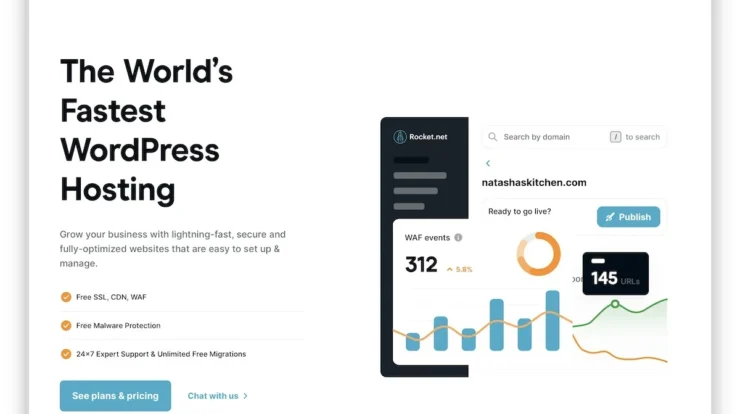
Modern web applications, especially those built with React, increasingly rely on robust APIs to facilitate seamless user interactions and data exchange.
Choosing the right hosting platform for your React API is crucial for performance, scalability, and security, ultimately impacting user experience and the overall success of your application.
A poorly performing or unreliable API can lead to frustrated users, slow response times, and a diminished reputation for your product or service.
This meticulous exploration delves into the nuances of selecting the best hosting for a React API, examining key factors like performance, cost-effectiveness, and the specific demands of various project scopes.
From cloud-based solutions to dedicated servers, understanding the strengths and weaknesses of each hosting type is paramount for developers seeking to optimize their React applications.
This comprehensive guide will equip you with the knowledge to choose a hosting provider that aligns perfectly with the specific needs and demands of your React API, ensuring its smooth operation and reliability.
Selecting the ideal hosting solution for your React API involves a careful consideration of factors such as expected traffic volume, data storage requirements, and security protocols. Choosing the correct best hosting for react api directly impacts the performance, scalability, and overall reliability of your application.
This article will scrutinize the critical criteria for selecting the best hosting for your React API, enabling you to make an informed decision that supports sustained application growth and optimal user experience.
Selecting the Ideal Hosting Platform for a React API
Choosing the right hosting environment is fundamental for a React API’s performance and scalability.
The optimal hosting solution directly impacts the speed and reliability of API responses, influencing user experience and the application’s overall success.
Selecting the appropriate hosting platform must consider factors like anticipated traffic, data volume, and budget constraints.
An API built with React requires hosting that can handle fluctuating demands and ensure consistent delivery of data.
A robust hosting platform will provide secure storage for API code, configuration files, and database interactions.
The scalability of the hosting solution is crucial for handling increasing user traffic and data volumes as the React application evolves and gains popularity.
A reliable React API hosting platform guarantees high availability and minimizes downtime, preventing user frustration and ensuring consistent service.
Different project needs dictate various hosting solutions, from shared hosting for smaller projects to dedicated servers for high-traffic applications.
Understanding the performance characteristics of various hosting types, such as cloud-based platforms, VPS servers, and dedicated servers, is vital.
Cost-effectiveness plays a key role in evaluating hosting options, with pricing models varying significantly among providers.
Analyzing features such as built-in security measures, data backup options, and monitoring tools are crucial components for a secure and reliable hosting environment.
A well-structured and maintained hosting environment will directly contribute to the security of the React API and its associated data.
The choice of best hosting for a React API depends on factors like the specific requirements of the application, its anticipated growth trajectory, and the financial resources available.
Choosing a hosting provider offering excellent customer support is beneficial during the setup and maintenance phases of the React API.
Evaluating the reliability and stability of the hosting provider’s infrastructure is essential, as this directly affects the React API’s uptime and responsiveness.
Thorough research and comparisons across various hosting providers are vital to selecting the best option that suits a React API’s unique needs.
The success of a React API hinges on the selection of a hosting service that balances performance, security, and budget-friendliness.
Choosing the correct hosting provider for a React API, considering these factors, ultimately sets the stage for a smooth and user-friendly user experience.
Performance Considerations in React API Hosting
Performance is paramount for a successful React API, directly influencing user experience and application reputation.
Choosing a hosting solution with optimized infrastructure and efficient resources is critical for consistently fast response times.
Latency, the time delay between a user request and the API response, significantly impacts the perceived speed of the application.
Minimizing latency is crucial for maintaining a positive user experience and preventing frustrating delays.
A well-chosen hosting platform can leverage server locations strategically positioned geographically close to users, further reducing latency.
Measuring API performance metrics, such as response time and throughput, provides valuable insights to identify bottlenecks and potential areas for improvement.
Scalability directly affects the hosting solution’s ability to manage fluctuating demands, essential for a robust React API.
An optimal hosting platform needs to gracefully accommodate increases in traffic and data volume without sacrificing performance.
Reliable hosting services use load balancing techniques to distribute incoming requests across multiple servers, ensuring consistent performance even during peak usage.
High-performance hosting for React APIs often employs optimized server configurations and robust caching mechanisms, improving speed.
Automated scaling features, integrated into the hosting platform, allow the system to dynamically adjust resources based on demand.
Cloud-based solutions often excel at automatic scaling, adapting to changing workload levels without requiring manual intervention.
Efficient use of caching strategies, like browser caching and server-side caching, further enhance performance and reduce the load on the API.
Careful consideration of these performance attributes when selecting a hosting platform for your React API is crucial for long-term success.
A dedicated server, while offering potential for customization, may not inherently offer the same automatic scaling capabilities as cloud-based solutions.
Understanding the specifics of scaling, particularly regarding load balancing, helps developers optimize their React API hosting setup.
Monitoring performance metrics and regularly evaluating the hosting platform’s response to changing demands is vital for a smooth user experience.
With a well-configured hosting infrastructure, developers can ensure their React API remains responsive and reliable, thereby maximizing user engagement.
Robust server-side infrastructure, combined with appropriate caching strategies, plays a vital role in delivering a fast, scalable, and reliable React API.
Optimizing the hosting platform is not just about selecting the right provider; it’s about strategically implementing best practices that cater to the specific needs of the React API application.
Scalability and Performance Considerations for React API Hosting
Choosing the right hosting solution for a React API is crucial for ensuring smooth performance and scalability as your application grows.
Scalability, in this context, means the ability of the hosting platform to handle increasing user traffic, data volume, and API requests without compromising response times or stability.
Performance, conversely, refers to how quickly the API responds to client requests, directly impacting user experience.
A poorly performing or unscalable API can lead to frustrated users, decreased engagement, and even a negative impact on your application’s reputation.
Therefore, understanding and addressing scalability and performance is paramount when selecting a hosting solution for your React API.
Modern web applications, particularly those built with React and leveraging APIs, are often characterized by a dynamic user base and variable data loads. For example, an e-commerce application with a React front-end and a corresponding API might experience peaks in traffic during promotional periods.
A good hosting platform for a React API needs to adapt to these fluctuations without causing latency or service interruptions.
The infrastructure supporting your API needs to be able to easily scale up resources when the demand increases and scale down when the demand drops, maintaining optimal resource utilization.
Key factors impacting scalability and performance include server configuration, network infrastructure, and the specific architecture of the hosting platform.
For a React API, features such as load balancing, caching mechanisms, and optimized database configurations are crucial elements of a high-performing hosting solution.
Load balancing distributes incoming traffic across multiple servers, preventing overload on any single machine. This ensures that requests are processed efficiently and quickly, thereby reducing latency.
Caching frequently accessed data on the server or edge can significantly speed up response times for API requests, improving performance and user experience.
Furthermore, the database configuration must be optimized for speed and efficiency to reduce delays in data retrieval and manipulation. A well-designed database schema and indexing are critical considerations for a scalable and performing React API.
Cloud-based hosting platforms often excel in providing scalable hosting options with automatic resource allocation. These environments are more adaptive to fluctuating demand compared to traditional dedicated server hosting, often providing a more cost-effective approach in the long run.
Ultimately, a robust hosting environment for a React API must be able to effortlessly handle potential spikes in traffic, ensuring a consistent and reliable user experience for all consumers of your application.
Considering these scalability and performance aspects when researching **best hosting for react api** solutions is essential for building a future-proof application.
Scalability and Performance for a High-Volume React API
Scalability is paramount when designing a robust React API, especially as user base and data volume grow.
A well-designed hosting solution should effortlessly handle increasing traffic loads without compromising performance. This is crucial for a positive user experience and maintaining application availability.
Choosing a hosting platform capable of horizontal scaling is essential for a React API. This means the system should be able to distribute the load across multiple servers, ensuring minimal downtime and quick response times, even during peak usage.
For a React API, the specific hosting architecture should support efficient processing of requests. Load balancing, which distributes incoming traffic across multiple servers, is a fundamental component of scalable hosting. This helps prevent a single server from becoming overwhelmed.
The performance of the hosting infrastructure directly impacts the response time of your React API. Fast response times are vital for a smooth user experience; slow API responses can lead to frustration and a poor user perception of your application.
A solid hosting provider will offer detailed monitoring tools and performance metrics to track the React API’s behavior under various load conditions. This data allows for proactive adjustments to ensure optimal performance and to identify potential bottlenecks early on, ultimately preventing service disruptions. This is critical for a scalable React API architecture.
When deciding on a React API hosting solution, consider the hosting provider’s ability to handle spikes in traffic. Sudden increases in user activity can overwhelm an under-equipped system, leading to service degradation or outages. Therefore, the hosting provider’s capacity to maintain performance during high-traffic periods is an important factor.
Advanced features such as automatic scaling and serverless functions should be considered, offering automated adjustments to hosting resources according to real-time demand. This flexibility is essential for a React API to scale effectively with its use and remain responsive.
In summary, a scalable and high-performance hosting environment is critical for a successful React API. This ensures your application maintains responsiveness and reliability under various load conditions, fostering a good user experience.
Choosing the right hosting platform for a React API is crucial for performance, scalability, and ultimately, user experience.
The article highlighted the critical factors – speed, reliability, security, and cost-effectiveness – that must be considered when selecting a hosting solution tailored to the specific needs of a React API.
From cloud providers like AWS and Azure to specialized managed hosting services, the options discussed provided a nuanced perspective, guiding developers towards making informed decisions.
Ultimately, the best hosting for React API hinges on factors such as anticipated traffic volume, data storage needs, and budget constraints. Selecting a hosting solution that accommodates these variables ensures a robust, reliable, and performant API backend that supports your application.
Considering the specific demands of React applications, from seamless data retrieval to real-time updates, choosing the optimal **hosting for React API** is paramount to maintaining the high standards of a well-performing application. This careful consideration ensures that the API’s responsiveness remains consistent under increasing loads, maintaining a smooth user experience and ultimately increasing user satisfaction.
The optimal approach involves a thorough evaluation of available options, ensuring the chosen platform possesses the necessary resources to accommodate future growth and support the application’s long-term needs. By addressing these critical considerations, developers can confidently deploy a React API that delivers an exceptional user experience.






